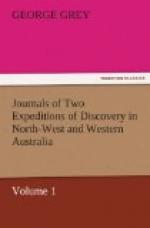The next to give way was Ringhalz, a fine Cape buck-hound; he fell amongst the rocks, and died almost instantly. The only dog now left was a greyhound, who manifested his extreme distress by constantly lying down. For some time we dragged him along, but he was at last from necessity abandoned. The cry of water was at length raised by one of the party, and immediately afterwards we found ourselves on the edge of a deep ravine, the precipitous sides of which were composed of nearly horizontal layers of red sandstone. Down these some of us contrived to scramble, although not without difficulty; but on reaching the bottom we had the mortification to find the water salt; and as it would have been very laborious to follow its course along the bottom of the ravine over the mud, mangroves, and rocks which filled it, we had the pleasure of scrambling up again as we best could.
For some short time we remained seated on the edge of the cliffs above the ravine; but as there was no shelter here from the sun’s rays, and the pangs of thirst were pressing, I roused the men at last, and moved on again, following the course of the ravine upwards. We had not walked more than half a mile when the salt water inlet terminated and the bed of the ravine became thickly wooded. At the moment we gained this point some white cockatoos came soaring upwards from beneath our feet; and, as we knew that this was an infallible sign of the presence of water, we descended again to renew our search for it.
Water discovered.
Our efforts this time were successful: in a few minutes we found a pool of brackish water which appeared, under the present circumstances, to afford the most delicious draughts, and, having drunk, we lay down by the pool to rest ourselves. Being however doubtful as to which was the best route to lead us out of the ravine we were now in, I walked up its course, accompanied by Corporal Coles, leaving the others to rest themselves, and soon reached its head; when we found ourselves in a small but fertile valley, surrounded on all sides by rocky hills. Here were many tracks of natives, and we came upon one of their regular haunts, where they had arranged a circle of large flat stones round a fireplace occupying the centre; on each of these stones was laid a smaller one, evidently used for the purpose of breaking small shellfish, for the remains of the shells were lying scattered about in all directions;* kangaroo bones were also plentifully strewed about, and beside each pair of stones was laid a large shell, probably used as a drinking cup.
(Footnote. We found the marks of an encampment of a tribe of natives. Eight or nine spots were cleared away amongst the grass, and in the centre of each were the ashes of a small fire, close to which we noticed some loose flattened stones with a smaller one lying upon them, which the natives probably used for the purpose of bruising or grinding the seeds of plants and breaking shellfish. King’s Survey of Australia volume 1 page 302.)




